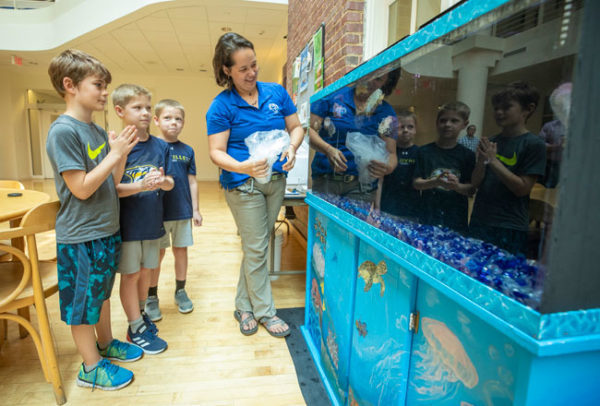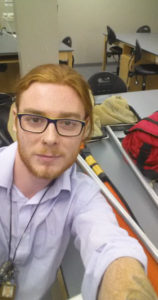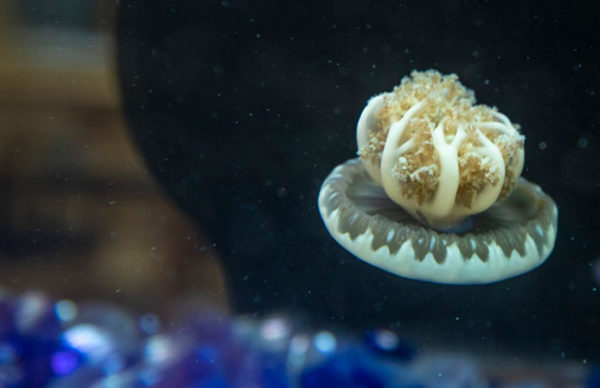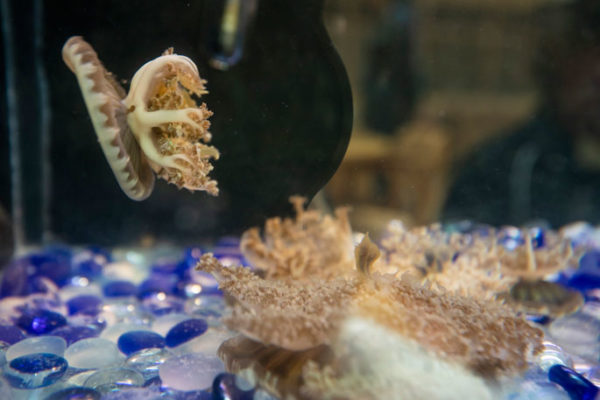First-year undergraduates are not the only new arrivals on Vanderbilt’s campus this week. Joining them are more than a dozen Cassiopea, more commonly known as “upside-down jellyfish,” provided by marine biologists at the Tennessee Aquarium in Chattanooga.
The upside-down jellyfish, so named because they cluster at the bottom of warm shallow mangrove swamps with their tentacles facing up toward sunlight, now reside in a 55-gallon aquarium in the Wyatt Center atrium, home to Peabody College’s Department of Teaching and Learning and the School for Science and Math at Vanderbilt. This new habitat will serve as a hands-on learning tool for Metro Nashville public high school students participating in the SSMV’s advanced science program. The aquarium is also available for viewing by the general public.


SSMV instructor and marine biologist Jordan Grigor, who has a doctorate in oceanography, facilitated the jellyfish collaboration. He believes that SSMV students will benefit from learning about this unusual species and will come away with a better understanding of the need for ocean preservation and protecting marine life.
“It’s really great to work with the Tennessee Aquarium, because they are helping us bring the oceans to students here in Nashville, which is some distance away from the nearest sea,” Grigor said. “We are currently very interested in upside-down jellyfish because they have very cool life cycles … and much of their lives is spent resting upside down on the bottom.”
The jellyfish have a symbiotic relationship with the algae that reside in their tissues, giving them their brownish color. The algae in turn receive shelter and use products produced by the jellyfish to survive.

“The upside-down jellyfish are interesting because the zooxanthellae (algae) in their tissues make them similar to some types of coral,” said Amanda Dixon, SSMV admissions coordinator. “They grow quickly and multiply under the right conditions, so it will be exciting to watch them adapt to this new habitat.”

SSMV students spent the summer preparing the jellyfish habitat, including painting a mural of marine life on the base of the system, and cycling the water for the delicate creatures’ arrival.
“In adverse conditions, especially increasing temperatures due to global warming and other factors, the algae get stressed or die and the jellyfish expel them, leaving both partners to suffer,” Grigor said. “These types of lessons about jellyfish biology and ecology will help to reinforce our students’ interest and passion to help protect them.”
SSMV also has a 90-gallon reef tank, which provides students opportunities to learn about and care for fish, corals, starfish and algae. The students are learning how marine creatures interact, collaborate and rely on each other for survival.
“Getting to do research is the best part of being in SSMV,” said Carlos Salas, a Hume-Fogg senior and SSMV participant. “It’s such a great opportunity.”
Recently, he helped create a smartphone app to identify zooplankton, a first of its kind.

SSMV is a program of the Vanderbilt Center for Science Outreach in Peabody’s Department of Teaching and Learning. It is a joint venture with Metro Nashville Public Schools. Students are selected as freshmen, based on their grades, aptitude and passion for learning.
Throughout high school, the students spend one day a week in the SSMV classroom/laboratory on the Vanderbilt campus, learning from Vanderbilt instructors about a broad variety of topics, including computer science, marine biology, robotics and much more. As they progress, students specialize in a field of choice and conduct research alongside scientists in their labs, as well as enter research projects into national science competitions and submit to research journals.

Follow SSMV on social media:
Twitter: @SSMVAquarium, @SSMVandy, @scotland2arctic
Facebook: @SSMVtheschool @SSMVAquarium
A version of this article appeared previously on Research News @ Vanderbilt.